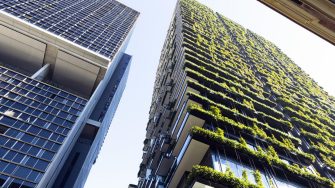
Environmental engineering has a profound impact on the world’s environmental problems. Environmental engineers identify environmental problems and develop effective ethical and social responsible solutions to combat them.
As a graduate in in this field of Engineering, you may manage projects that look to limit environmental damage from engineering works. You’ll look at restoring natural ecosystems, improve water supply, combat negative effects of climate change or be involved in the research and development of government environmental policy.

Our degrees
Explore our range of environmental engineering degrees and get ready to launch your career.
Environmental engineering combines aspects of civil engineering such as project management, systems design, geotechnical and transport engineering, with aspects of chemical engineering and biological sciences.
-
Sustainable engineering takes environmental engineering concepts to the next level and looks at the interactions between technical, ecological, social and economic systems. Sustainability means living well within the ecological limits of a finite planet. Engineers need to find holistic and effective solutions to protect vital life support systems and, at the same time, meet the needs of a growing human population. Concepts such as life cycle thinking, industrial ecology and sustainable systems engineering are important elements of this discipline.
As a sustainable engineer, you could work on solutions for the world’s most important challenges such as climate change, water availability, energy futures, water management, low-carbon living and more.
-
Water engineering looks at how water interacts with all aspects of the built and natural environments. Water engineers investigate the way that dynamic natural systems such as rivers, estuaries and the coasts behave, as well as design infrastructure to store and direct water.
Some of the challenges water engineers address include:
- rainfall and storm prediction modelling taking into account climate change
- water supply needs in different parts of Australia: drinking water, water for industry and agriculture, including wastewater treatment, and water for the natural environment - this may include combinations of dams, groundwater, recycled water and desalinated water
- flood prediction and management: one of the costliest natural disasters for Australia
- groundwater management: water that lies in underground aquifers and deep in the soil
- coastal management: how do we manage the coasts as sea levels rise? How do we effectively protect civil infrastructure, coastal groundwater resources, beaches and estuaries?
- rainfall and storm prediction modelling taking into account climate change
-
Transport engineering covers the behaviour, optimisation and management of transport systems. Transport engineers plan, design and operate the large public and private infrastructure systems that connect our physical world. Modern society depends on a broad range of continually evolving, large-scale transport infrastructure, including road, rail, air and water. Transport engineers quantify and optimise our mobility infrastructure networks to meet travel and freight demands, while ensuring safety, equity and sustainability, at minimal levels of congestion and cost.
Transport planning involves developing calibrated mathematical techniques for forecasting travel demand and commuter behaviour. This needs to be based on many challenging variables such as:
- population growth
- changes from petroleum to electrical based power
- share vehicles
- future technological advances
- government emissions policy changes.
Transport engineers face multi-faceted design decisions when they are designing optimised transport infrastructure networks. In all design decisions, multiple performance measures, cost metrics and safety criteria must be considered and weighed. These might relate to:
- the physical expansion of transport facilities, such as lane width or the number of lanes, for a roadway
- the materials and thickness used in pavements
- the geometry of a facility, such as a roadway, rail line or airport
- road pricing schemes
- deploying information-based technology.
Transport operations, whether for road, rail, port or air traffic, are designed to minimise travel delays, improve safety, reduce emissions and enhance reliability, as well as taking other considerations into account. Transport operation decisions may involve optimising traffic signals, setting specific tolls, and designing traffic signs and markings.
- population growth

